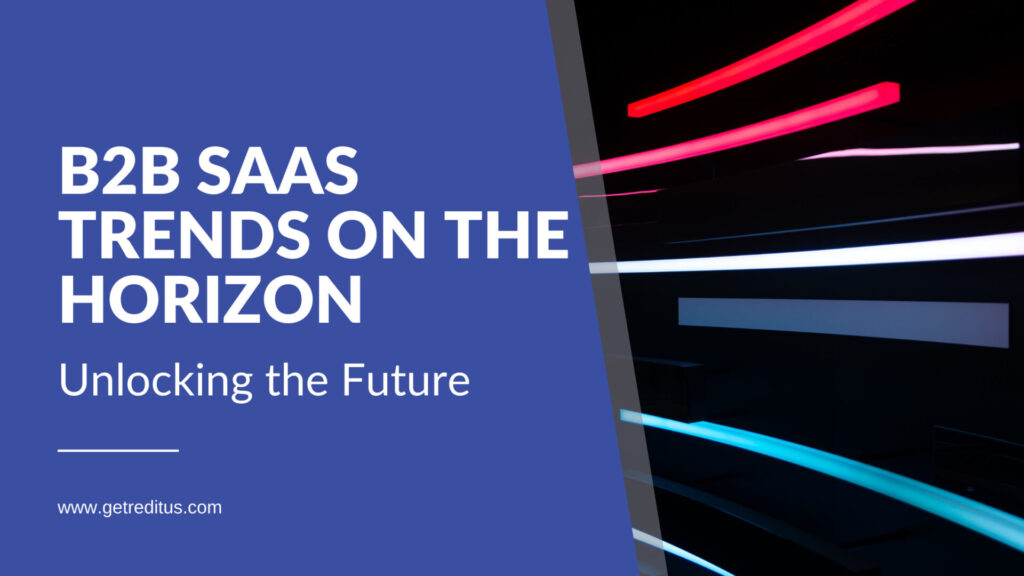Unlocking the Future: B2B SaaS Trends on the Horizon

The world of B2B SaaS is constantly evolving, and staying ahead of the curve is crucial for businesses to remain competitive. In this article on SaaS marketing trends, we'll take a look at the current state of the industry and explore some of the top things we can expect to see in the upcoming five years, domestically and in global SaaS markets.
Table of contents
- State of the B2B SaaS Industry
- B2B SaaS Industry Trends in 2023
- What B2B Trends in SaaS to Expect in the Upcoming Years
- Hybrid Cloud Adoption on the Rise
- Edge Computing Gains Traction
- Rise of AI-based Tools and Applications
- AI-powered Marketing Automation
- Predictive Analytics for Sales and Customer Support
- Increased Demand for Cloud Security Solutions
- Growing Importance of Identity and Access Management (IAM)
- Adoption of Zero Trust Security Model
- Growth of Subscription-Based Business Models
- Shift from Traditional License-Based Models
- Adoption of Usage-Based Pricing Models
- SaaS Marketplaces: The Next Big Thing?
- Increased Adoption of Pay-As-You-Go Pricing
- Importance of Price Flexibility and Transparency
- Dynamic Discounting for Better Cash Flow Management
- Rise of Bundling and Upselling Strategies
- Product Bundles: Offering More Value to Customers
- Upselling and Cross-Selling Techniques for Increased Revenue
- Focus on Customer Experience and Retention
- Rise of Customer-Centric Business Models
- Personalization for Better Customer Engagement
- Humanizing Customer Support with Chatbots
- Increased Adoption of Customer Success Strategies
- Expansion Revenue: Retaining and Upselling Existing Customers
- Implementing Voice of Customer (VoC) Programs
- Use of Data Analytics to Improve Customer Experience
- Predictive Analytics for Better Customer Insights
- Customer Journey Mapping for Improved Experience
- SaaS Future Trends
- Conclusion
State of the B2B SaaS Industry
Before diving into the future, let's take a look at where we stand today. The B2B SaaS industry has grown rapidly over the past few years, with an estimated market size of $167 billion in 2022. This growth is expected to continue, with projections showing a market size of over $232 billion by 2024.
One of the key drivers of this growth is the increasing adoption of cloud technology, which has enabled businesses to access software and services remotely, from anywhere and on pretty much any device.
Being able to run your business from your phone or tablet is pretty awesome. It also opens many doors and opportunities not only for the personal lives of your staff, like traveling and remote work, it also allows for pushing into new areas geographically for previously untapped business.
B2B SaaS Industry Trends in 2023
This year is a big one for the SaaS niche. There are a couple of obvious ones, like:
AI SaaS
AI has taken center stage far faster than anyone could've predicted. Not only is AI impacting the writing and service industries, machine learning is also making huge leaps as well and will soon be turning the manufacturing industry on its head in much the same way that the introduction of the assembly line did.
Micro SaaS
Micro SaaS, once perceived as a small-scale or niche business model, is now gaining increased recognition and becoming a sought-after title in the world of software solutions.
As more entrepreneurs and businesses realize the value of catering to specific customer needs and offering specialized services, the demand for Micro SaaS products has grown significantly. These smaller, focused software solutions are designed to address particular pain points or streamline specific processes, making them an attractive option for customers seeking simplicity, efficiency, and targeted functionality.
Everyone is talking about current SaaS trends and SaaS industry growth. What about the next five years? Using our own analytics, we have compiled a list of upcoming trends.
What B2B Trends in SaaS to Expect in the Upcoming Years
Like anything in technology, change is rapid and inevitable. SaaS is no different. The next five years will bring monumental growth to the SaaS landscape and likely revolutionize areas of business that we've never even considered.
Increased Adoption of Cloud Computing
While cloud technology has been around for a while now, its adoption is only expected to increase in the coming years. This is due in part to the flexibility and scalability it offers, allowing businesses to easily adjust their resources to meet changing demands.
Hybrid Cloud Adoption on the Rise
As more businesses adopt cloud technology, we expect to see more hybrid cloud environments. This refers to a combination of public and private cloud solutions, offering the best of both worlds regarding security and scalability.
Edge Computing Gains Traction
Edge computing involves processing data closer to the source rather than relying on centralized cloud servers. The result is reduced latency and improved real-time insights, making it an attractive option for businesses looking to maximize efficiency.
Rise of AI-based Tools and Applications
AI has already made significant strides in the B2B SaaS industry, but we can expect to see even more advanced tools and applications in the coming years.
AI-powered Marketing Automation
Marketing automation has been a game-changer for many businesses, and AI is poised to take it to the next level. With advanced machine learning algorithms, marketers can deliver highly personalized content and offers to their target audience.
Predictive Analytics for Sales and Customer Support
Predictive analytics can help businesses gain valuable insights into their customers' behaviors and preferences, allowing them to tailor their sales and support strategies accordingly.
Increased Demand for Cloud Security Solutions
As more businesses rely on cloud technology, security will become more pressing. Here are some key trends to keep in mind:
Growing Importance of Identity and Access Management (IAM)
IAM solutions help ensure that only authorized individuals can access sensitive data and resources. As businesses adopt cloud technology, IAM will become increasingly important for maintaining security.
Adoption of Zero Trust Security Model
The zero-trust security model is based on the idea of never trusting anyone or anything by default, regardless of whether they are inside or outside the organization. This approach helps ensure that the damage is limited even if a breach occurs.
Growth of Subscription-Based Business Models
Subscription-based business models have become increasingly popular in recent years, which is expected to continue. Here are some key factors driving this growth:
Shift from Traditional License-Based Models
Traditional license-based models require businesses to make a significant upfront investment, which can be a barrier to entry for many. On the other hand, subscription models offer more flexibility and scalability while generating consistent revenue for the provider.
Adoption of Usage-Based Pricing Models
Usage-based pricing models allow businesses to pay only for what they use, which can be especially appealing for those with fluctuating demands.
SaaS Marketplaces: The Next Big Thing?
SaaS marketplaces like Salesforce AppExchange and Microsoft AppSource serve as centralized platforms for businesses to discover, purchase, and manage cloud-based software applications and are expected to grow in popularity as businesses seek to streamline their procurement processes and consolidate their software portfolios.
Increased Adoption of Pay-As-You-Go Pricing
Pay-as-you-go pricing models, which allow businesses to pay for the services they use flexibly, are becoming more popular in the B2B SaaS market, driven by the need for cost control and scalability.
Importance of Price Flexibility and Transparency
As businesses increasingly prioritize price flexibility and transparency, SaaS providers will need to adapt their pricing strategies to meet these demands, offering more granular and customizable pricing options.
Dynamic Discounting for Better Cash Flow Management
Dynamic discounting, which involves offering discounts to customers in exchange for early payment, is expected to gain traction as a cash flow management tool for both SaaS providers and their customers.
Rise of Bundling and Upselling Strategies
B2B SaaS providers are increasingly adopting bundling and upselling strategies to increase customer lifetime value and drive revenue growth.
Product Bundles: Offering More Value to Customers
By offering product bundles that combine multiple features or services into a single package, SaaS providers can deliver greater value to their customers while potentially increasing average transaction values.
Upselling and Cross-Selling Techniques for Increased Revenue
Upselling and cross-selling techniques, such as offering premium features or complementary products, can help SaaS providers generate additional revenue from existing customers.
Focus on Customer Experience and Retention
In an increasingly competitive market, B2B SaaS providers must prioritize customer experience and retention to remain successful. Key trends in this area include:
Rise of Customer-Centric Business Models
Businesses are increasingly adopting customer-centric business models, which prioritize customer satisfaction and loyalty over short-term revenue goals.
Personalization for Better Customer Engagement
Personalization, driven by AI and data analytics, will play a crucial role in enhancing customer engagement and improving the overall customer experience.
Humanizing Customer Support with Chatbots
Chatbots, powered by AI and natural language processing (NLP) technologies, will help humanize customer support interactions by providing timely, personalized, and contextually relevant assistance.
Increased Adoption of Customer Success Strategies
Customer success strategies, which focus on helping customers achieve their desired outcomes using a product or service, are becoming more prevalent in the B2B SaaS market.
Expansion Revenue: Retaining and Upselling Existing Customers
Expansion revenue, generated by retaining and upselling existing customers, will become increasingly important for SaaS providers seeking to drive sustainable growth.
Implementing Voice of Customer (VoC) Programs
VoC programs, which involve collecting and analyzing customer feedback to inform product development and business strategy, will play a critical role in driving customer satisfaction and loyalty.
Use of Data Analytics to Improve Customer Experience
Data analytics will be increasingly leveraged by B2B SaaS providers to gain valuable customer insights and improve the overall customer experience.
Predictive Analytics for Better Customer Insights
Predictive analytics, powered by AI and ML technologies, will enable businesses to identify trends and patterns in customer behavior, helping them make more informed decisions and deliver a better customer experience.
Customer Journey Mapping for Improved Experience
Customer journey mapping, which involves visualizing the various touchpoints and interactions that customers have with a brand, will become an essential tool for identifying areas of improvement in the customer experience.
SaaS Future Trends
As the B2B SaaS market continues to evolve, several emerging technologies and markets are expected to shape the future of the SaaS industry.
Increased Adoption of Internet of Things (IoT)
IoT technology is expected to play a significant role in the future of the B2B SaaS market, offering new opportunities for innovation and growth.
The IoT is a vast network of interconnected devices, sensors, and objects that collect and exchange data to enhance automation, efficiency, and decision-making processes. IoT enables everyday items, such as home appliances, wearable devices, and industrial machinery, to communicate with each other and share information through the internet. SaaS, or Software as a Service, plays a crucial role in the IoT ecosystem by providing cloud-based software solutions that can efficiently manage, analyze, and utilize the vast amounts of data generated by IoT devices.
Businesses that work to integrate IoT with SaaS platforms will be able to make more informed decisions in everything from product development to marketing.
IoT for Predictive Maintenance and Supply Chain Optimization
By integrating IoT devices and sensors into their platforms, SaaS providers can offer predictive maintenance and supply chain optimization solutions that help businesses minimize downtime and reduce operational costs.
Edge Computing and IoT for Real-Time Analytics
Edge computing and IoT have emerged as a powerful duo for real-time analytics, revolutionizing the way businesses process and interpret data. In edge computing, data is processed closer to the source, such as the IoT devices themselves, rather than being sent to centralized data centers or cloud servers for analysis.
This approach reduces latency, enhances data privacy, and minimizes network congestion, enabling faster and more efficient data processing. When combined with IoT, edge computing empowers businesses to make informed decisions based on real-time insights, which is particularly valuable in industries like manufacturing, transportation, and healthcare.
By utilizing edge computing and IoT for real-time analytics, organizations can optimize their operations, predict potential issues before they escalate, and swiftly respond to changing circumstances, ultimately leading to improved efficiency, cost savings, and a competitive edge in the market.
Conclusion
As we continue into 2023, it will be interesting to see which predictions come true and how businesses take advantage of them. Businesses that are able to capitalize on new SaaS trends and technologies such as AI and cloud computing can get a jumpstart in their growth strategy.
Reditus is a great option for those looking to maximize their MRR without making high upfront costs. We offer unique capabilities that help our customers leverage these advances in technology for their long-term success. By combining all of that with our sleek, easy-to-use platform, Reditus takes the hassle out of setting up and harvesting the rewards from your next big SaaS move.

